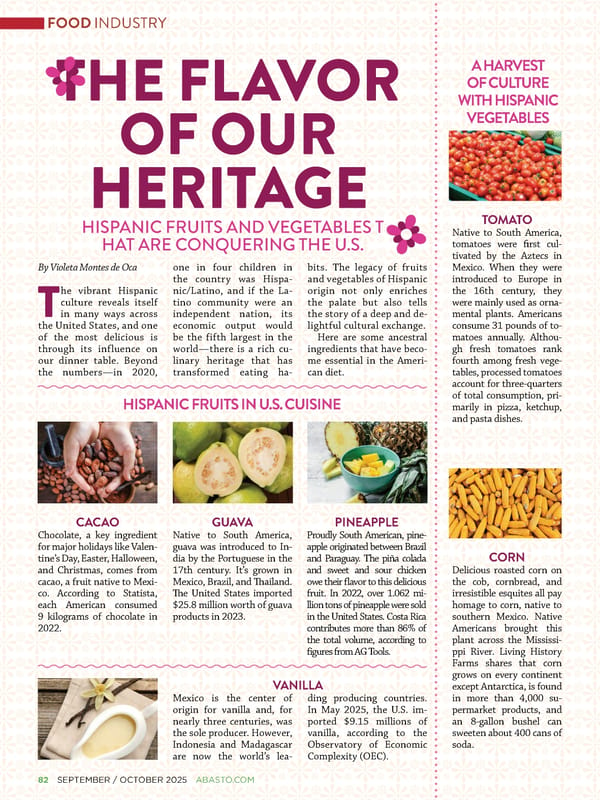82�SEPTEMBER / OCTOBER 2025�ABASTO.COM TOMATO Native to South America, tomatoes were frst cul- tivated by the Aztecs in Mexico. When they were introduced to Europe in the 16th century, they were mainly used as orna- mental plants. Americans consume 31 pounds of to- matoes annually. Althou- gh fresh tomatoes rank fourth among fresh vege- tables, processed tomatoes account for three-quarters of total consumption, pri- marily in pizza, ketchup, and pasta dishes. FOOD INDUSTRY HISPANIC FRUITS AND VEGETABLES T HAT ARE CONQUERING THE U.S. THE FLAVOR OF OUR HERITAGE HISPANIC FRUITS IN U.S. CUISINE CACAO Chocolate, a key ingredient for major holidays like Valen- tine’s Day, Easter, Halloween, and Christmas, comes from cacao, a fruit native to Mexi- co. According to Statista, each American consumed 9 kilograms of chocolate in 2022. GUAVA Native to South America, guava was introduced to In- dia by the Portuguese in the 17th century. It’s grown in Mexico, Brazil, and Tailand. Te United States imported $25.8 million worth of guava products in 2023. PINEAPPLE Proudly South American, pine- apple originated between Brazil and Paraguay. The piña colada and sweet and sour chicken owe their flavor to this delicious fruit. In 2022, over 1.062 mi- llion tons of pineapple were sold in the United States. Costa Rica contributes more than 86% of the total volume, according to figures from AG Tools. VANILLA Mexico is the center of origin for vanilla and, for nearly three centuries, was the sole producer. However, Indonesia and Madagascar are now the world’s lea- ding producing countries. In May 2025, the U.S. im- ported $9.15 millions of vanilla, according to the Observatory of Economic Complexity (OEC). A HARVEST OF CULTURE WITH HISPANIC VEGETABLES By Violeta Montes de Oca T he vibrant Hispanic culture reveals itself in many ways across the United States, and one of the most delicious is through its influence on our dinner table. Beyond the numbers—in 2020, one in four children in the country was Hispa- nic/Latino, and if the La- tino community were an independent nation, its economic output would be the fifth largest in the world—there is a rich cu- linary heritage that has transformed eating ha- bits. The legacy of fruits and vegetables of Hispanic origin not only enriches the palate but also tells the story of a deep and de- lightful cultural exchange. Here are some ancestral ingredients that have beco- me essential in the Ameri- can diet. CORN Delicious roasted corn on the cob, cornbread, and irresistible esquites all pay homage to corn, native to southern Mexico. Native Americans brought this plant across the Mississi- ppi River. Living History Farms shares that corn grows on every continent except Antarctica, is found in more than 4,000 su- permarket products, and an 8-gallon bushel can sweeten about 400 cans of soda.
 Abasto Magazine: September/October 2025 ENGLISH Page 97 Page 99
Abasto Magazine: September/October 2025 ENGLISH Page 97 Page 99